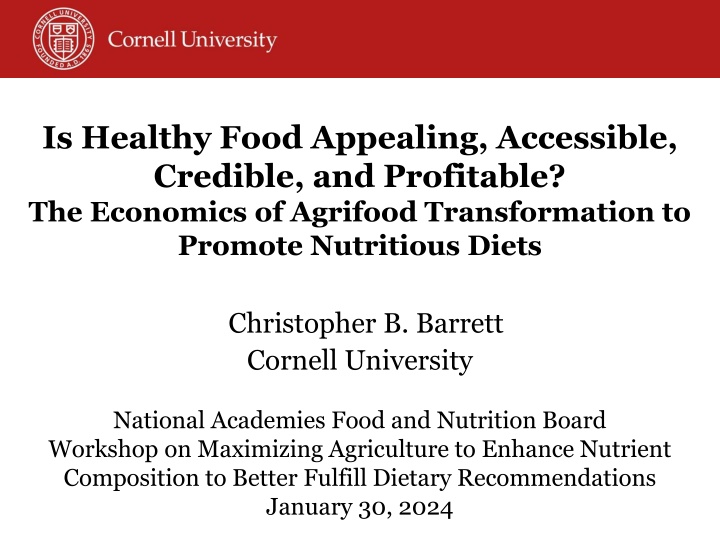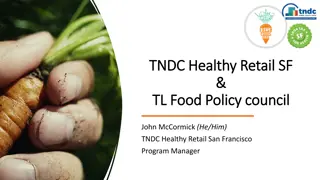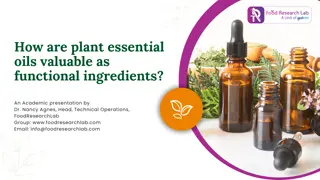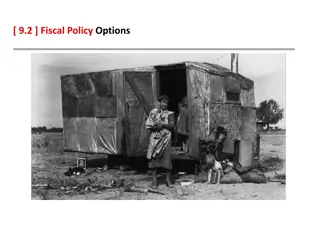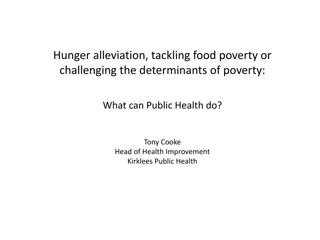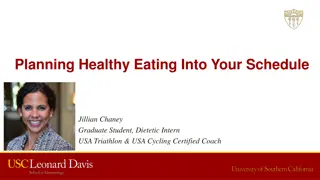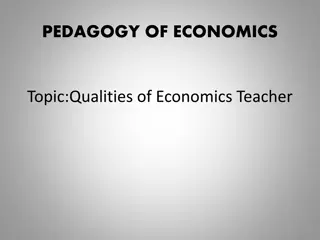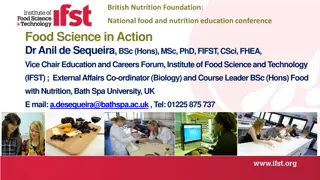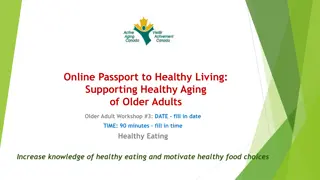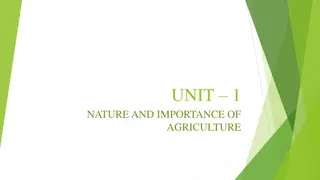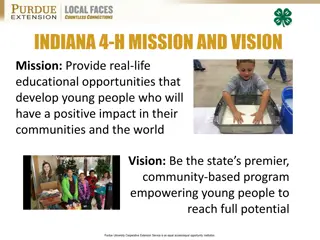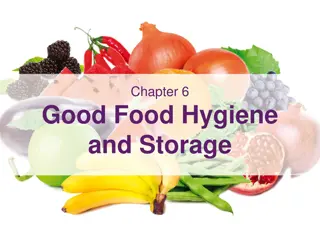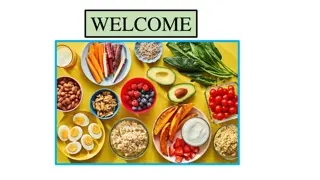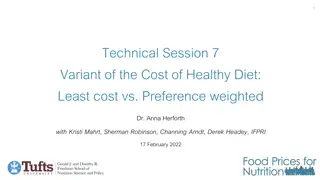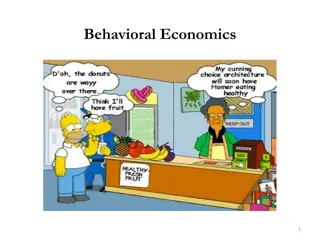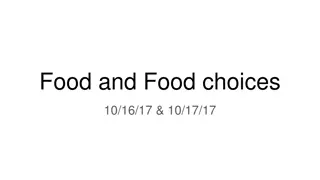The Economics of Healthy Food Choices
The economics of agrifood transformation to promote nutritious diets is crucial for both human and environmental health. Factors such as preferences, constraints, information, and incentives drive food production and consumption choices. Consumer demand, affordability, credibility of food claims, and production knowledge play key roles in shaping the availability and appeal of healthy foods in the market.
Uploaded on Sep 21, 2024 | 0 Views
Download Presentation

Please find below an Image/Link to download the presentation.
The content on the website is provided AS IS for your information and personal use only. It may not be sold, licensed, or shared on other websites without obtaining consent from the author.If you encounter any issues during the download, it is possible that the publisher has removed the file from their server.
You are allowed to download the files provided on this website for personal or commercial use, subject to the condition that they are used lawfully. All files are the property of their respective owners.
The content on the website is provided AS IS for your information and personal use only. It may not be sold, licensed, or shared on other websites without obtaining consent from the author.
E N D
Presentation Transcript
Is Healthy Food Appealing, Accessible, Credible, and Profitable? The Economics of Agrifood Transformation to Promote Nutritious Diets Christopher B. Barrett Cornell University National Academies Food and Nutrition Board Workshop on Maximizing Agriculture to Enhance Nutrient Composition to Better Fulfill Dietary Recommendations January 30, 2024
Economics Both human and environmental health depend on the diets we choose. Economics is the scientific study of choices and their consequences. Perhaps useful? What drives food production/consumption choices? (1)Preferences: does it appeal (sensorily, socioculturally)? (2)Constraints: is it accessible (money, time)? (3)Information: Are claims about a food s desirable attributes known and credible (to consumers/producers)? (4)Incentives: does it pay (productivity, prices, risk)?
Preferences Consumer demand drives economic phenomena, including (especially?) around food. Foods bring joy and are central to culture, not just a means to producing good health. People therefore seek foods that yield immediate sensory and social satisfaction. Especially in fast thinking mode around the >200 food decisions we make each day. Tastes can be cultivated, but typically change slowly as culture (and genetics) evolve. An improved food product only gains acceptance if it appeals to consumers on a basic sensory and sociocultural level. Norman Rockwell, Freedom from Want (1943)
Constraints Choice is limited by time/money (which resolve physical access limitations). Cost >3.1 bn people worldwide cannot afford a healthy diet. More nutrient rich foods are typically more expensive. Healthy foods that aren t affordable for the poor and working class, won t get eaten at scale. FAO, Cost and Affordability of a Healthy Diet (2023) Convenience Time is scarce. As wages rise, so does the opportunity cost of time spent on meals. In US, $ spent on food away from home > food at home. FS is fastest growing. More nutritious foods only get eaten if affordable/convenient for consumers. Barrett et al., J. Econ. Literature (2022)
Information People will pay a (small) premium for products or processes good/safe for them, others, or the planet if claimed benefits are credible (hopefully true!). Fundamental problems of credence goods , noisy signals and misinformation. But if the cost to provide/communicate that benefit > consumers WTP, then need gov t or industry to set/enforce standards (e.g., mineral/vitamin fortification). Source: copythatco.com Producers must know the production process that yields the benefits (extension). Need extension and credible/cost-effective labeling .
Incentives Producers must profit w/acceptable risk exposure. No producer can sustain losses indefinitely. Many can t withstand one catastrophic loss. Ag productivity turns on pests, soils and weather. So need to accelerate R&D to adapt and produce more food off-farm. (Yet it s falling in the US!!!) Source: USDA ERS Productivity and prices drive profits. Farm prices driven by mid-stream actors who get >70% consumer $ and influence consumer preferences. Need R&D for novel, healthy foods and processes, as well as extension and insurance for farmers and standards for processors/retailers.
Summary Agrifood systems innovations can advance health, equity, resilience and sustainability goals. Requires foods that are affordable, convenient, sensorily and socio-culturally appealing to consumers and profitable for producers and distributors. Any non-obvious benefits must be credibly/cheaply communicable or enforced via science-based standards. Thank you for your interest!
